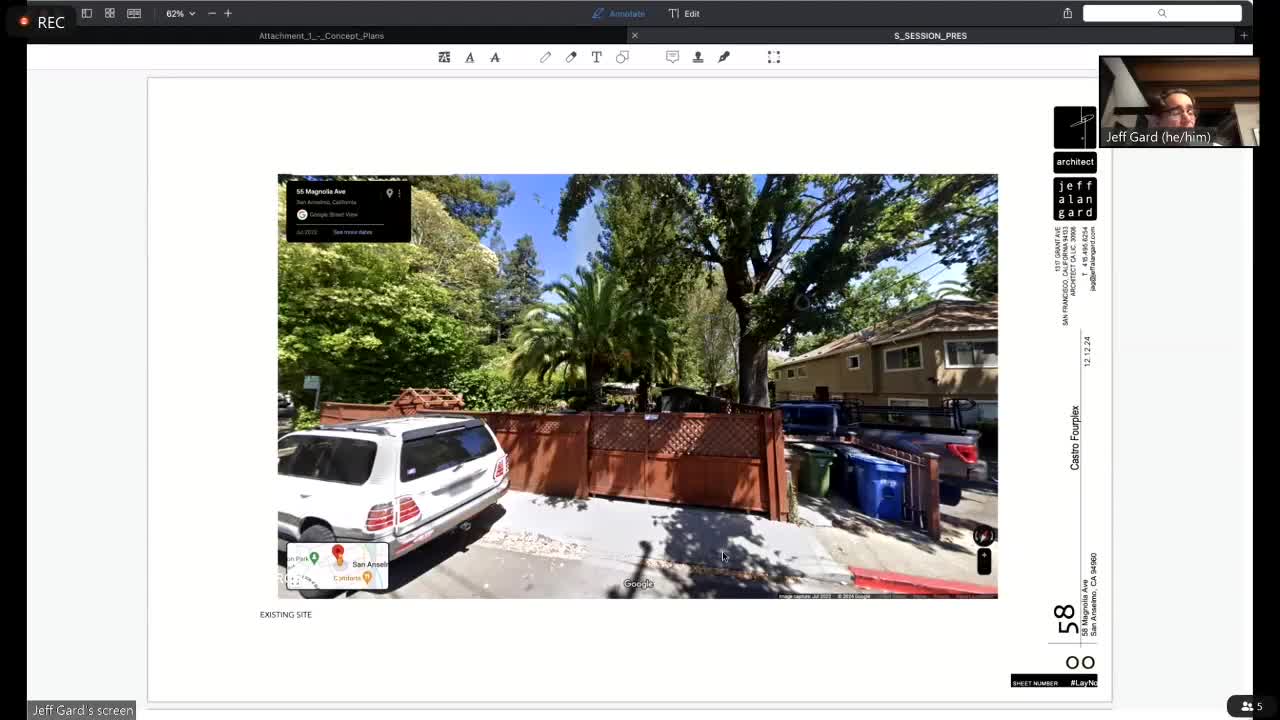Castro family proposes four-unit residential building in flood zone property
January 06, 2025 | San Anselmo Town, Marin County, California
This article was created by AI summarizing key points discussed. AI makes mistakes, so for full details and context, please refer to the video of the full meeting. Please report any errors so we can fix them. Report an error »

The San Anselmo Planning Commission has taken a significant step towards increasing housing availability in the area by reviewing a proposal for a new four-unit residential building. The project, presented by property owners Carlos and Soli Castro, aims to replace an existing single-family home on their nearly level lot, which is located in a designated flood zone.
The proposed development aligns with the town's residential zoning density, which permits 20 to 30 units per acre. The Castro's plan includes constructing a two-story building with one unit designated for Soli, while the remaining three units will be available for other residents. Each unit will feature one bedroom and one and a half baths, with sizes ranging from 1,034 to 1,043 square feet. The design incorporates dedicated parking spaces and private entries, ensuring minimal disruption to the existing street parking patterns.
In response to the floodplain concerns, the building's design distinguishes between upper and lower levels, with the second floor featuring natural wood siding and the ground floor designed to blend with the surrounding gardens. The project aims to maintain a light footprint and includes features such as light courts to enhance natural lighting and discreetly house HVAC components.
The planning process has seen several iterations, including feedback sessions with town staff and adjustments to comply with local regulations. However, the project faced a setback when the town determined that the proposed configuration would classify the units as townhouses rather than a fourplex, which is not permitted under the current regulations. As a result, the Castro family will need to pursue a zoning variance to move forward.
The Planning Commission's review of this proposal is crucial, as it not only addresses the immediate housing needs in San Anselmo but also sets a precedent for future developments in flood-prone areas. The outcome of this project could significantly impact the town's approach to housing density and resilience in the face of environmental challenges. The commission is expected to provide feedback and guidance on the proposed design, which will inform the next steps in the variance process.
The proposed development aligns with the town's residential zoning density, which permits 20 to 30 units per acre. The Castro's plan includes constructing a two-story building with one unit designated for Soli, while the remaining three units will be available for other residents. Each unit will feature one bedroom and one and a half baths, with sizes ranging from 1,034 to 1,043 square feet. The design incorporates dedicated parking spaces and private entries, ensuring minimal disruption to the existing street parking patterns.
In response to the floodplain concerns, the building's design distinguishes between upper and lower levels, with the second floor featuring natural wood siding and the ground floor designed to blend with the surrounding gardens. The project aims to maintain a light footprint and includes features such as light courts to enhance natural lighting and discreetly house HVAC components.
The planning process has seen several iterations, including feedback sessions with town staff and adjustments to comply with local regulations. However, the project faced a setback when the town determined that the proposed configuration would classify the units as townhouses rather than a fourplex, which is not permitted under the current regulations. As a result, the Castro family will need to pursue a zoning variance to move forward.
The Planning Commission's review of this proposal is crucial, as it not only addresses the immediate housing needs in San Anselmo but also sets a precedent for future developments in flood-prone areas. The outcome of this project could significantly impact the town's approach to housing density and resilience in the face of environmental challenges. The commission is expected to provide feedback and guidance on the proposed design, which will inform the next steps in the variance process.
View full meeting
This article is based on a recent meeting—watch the full video and explore the complete transcript for deeper insights into the discussion.
View full meeting
